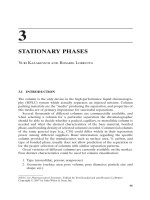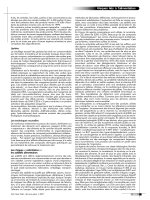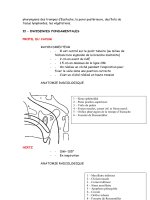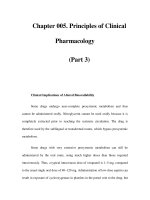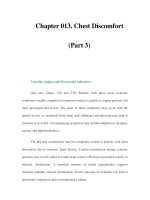Chapter 049. Sexual Dysfunction (Part 3) docx
Bạn đang xem bản rút gọn của tài liệu. Xem và tải ngay bản đầy đủ của tài liệu tại đây (85.39 KB, 7 trang )
Chapter 049. Sexual
Dysfunction
(Part 3)
Neurogenic
Disorders that affect the sacral spinal cord or the autonomic fibers to the
penis preclude nervous system relaxation of penile smooth muscle, thus leading to
ED. In patients with spinal cord injury, the degree of ED depends on the
completeness and level of the lesion. Patients with incomplete lesions or injuries
to the upper part of the spinal cord are more likely to retain erectile capabilities
than those with complete lesions or injuries to the lower part. Although 75% of
patients with spinal cord injuries have some erectile capability, only 25% have
erections sufficient for penetration. Other neurologic disorders commonly
associated with ED include multiple sclerosis and peripheral neuropathy. The
latter is often due to either diabetes or alcoholism. Pelvic surgery may cause ED
through disruption of the autonomic nerve supply.
Endocrinologic
Androgens increase libido, but their exact role in erectile function remains
unclear. Individuals with castrate levels of testosterone can achieve erections from
visual or sexual stimuli. Nonetheless, normal levels of testosterone appear to be
important for erectile function, particularly in older males. Androgen replacement
therapy can improve depressed erectile function when it is secondary to
hypogonadism; however, it is not useful for ED when endogenous testosterone
levels are normal. Increased prolactin may decrease libido by suppressing
gonadotropin-releasing hormone (GnRH), and it also leads to decreased
testosterone levels. Treatment of hyperprolactinemia with dopamine agonists can
restore libido and testosterone.
Diabetic
ED occurs in 35–75% of men with diabetes mellitus. Pathologic
mechanisms are primarily related to diabetes-associated vascular and neurologic
complications. Diabetic macrovascular complications are mainly related to age,
whereas microvascular complications correlate with the duration of diabetes and
the degree of glycemic control (Chap. 338). Individuals with diabetes also have
reduced amounts of nitric oxide synthase in both endothelial and neural tissues.
Psychogenic
Two mechanisms contribute to the inhibition of erections in psychogenic
ED. First, psychogenic stimuli to the sacral cord may inhibit reflexogenic
responses, thereby blocking activation of vasodilator outflow to the penis. Second,
excess sympathetic stimulation in an anxious man may increase penile smooth-
muscle tone. The most common causes of psychogenic ED are performance
anxiety, depression, relationship conflict, loss of attraction, sexual inhibition,
conflicts over sexual preference, sexual abuse in childhood, and fear of pregnancy
or sexually transmitted disease. Almost all patients with ED, even when it has a
clear-cut organic basis, develop a psychogenic component as a reaction to ED.
Medication-Related
Medication-induced ED (Table 49-1) is estimated to occur in 25% of men
seen in general medical outpatient clinics. Among the antihypertensive agents, the
thiazide diuretics and beta blockers have been implicated most frequently.
Calcium channel blockers and angiotensin-converting enzyme inhibitors are less
frequently cited. These drugs may act directly at the corporal level (e.g., calcium
channel blockers) or indirectly by reducing pelvic blood pressure, which is
important in the development of penile rigidity. Α Adrenergic blockers are less
likely to cause ED. Estrogens, GnRH agonists, H
2
antagonists, and spironolactone
cause ED by suppressing gonadotropin production or by blocking androgen action.
Antidepressant and antipsychotic agents—particularly neuroleptics, tricyclics, and
SSRIs—are associated with erectile, ejaculatory, orgasmic, and sexual desire
difficulties.
Table 49-1 Drugs Associated with Erectile Dysfunction
Classification Drugs
Diuretics Thiazides
Spironolactone
Antihypertensives Calcium channel blockers
Methyldopa
Clonidine
Reserpine
β-Blockers
Guanethidine
Cardiac/anti-hyperlipidemics
Digoxin
Gemfibrozil
Clofibrate
Antidepressants Selective serotonin reuptake inhibitors
Tricyclic antidepressants
Lithium
Monoamine oxidase inhibitors
Tranquilizers Butyrophenones
Phenothiazines
H
2
antagonists
Ranitidine
Cimetidine
Hormones Progesterone
Estrogens
Corticosteroids
GnRH agonists
5α-Reductase inhibitors
Cyproterone acetate
Cytotoxic agents Cyclophosphamide
Methotrexate
Roferon-A
Anticholinergics Disopyramide
Anticonvulsants
Recreational Ethanol
Cocaine
Marijuana
Although many medications can cause ED, patients frequently have
concomitant risk factors that confound the clinical picture. If there is a strong
association between the institution of a drug and the onset of ED, alternative
medications should be considered. Otherwise, it is often practical to treat the ED
without attempting multiple changes in medications, as it may be difficult to
establish a causal role for the drug.
